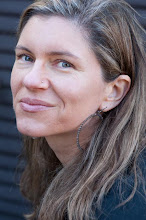
While planting my organic dye garden today, I banged my little toe. Ouch. Probably not broken, but my first thought was, “What about my rockin’ yoga habit?”
What to do when injured? From healing injured shoulders to little toes, yin is the answer.
Practice Yin Yoga. Check it out.
Yin yoga developed in the Taoist lineage in Ancient China. It’s based on passively-held yoga asanas, usually seated, that work the trunk, hips and legs. You hold these poses for 5-10 minutes. And you will be amazed at how these asanas unblock your chi flow through the meridians of your body, which happen to run through the connective tissue of your body. Connective tissue is where the action is -- it's what is worked, nourished and hydrated by Yin Yoga, and it's where injuries are healed by the action of fibroblasts and your immune system.
Local Abundance: Sarah Powers. We’re blessed in the Bay Area with Sarah Powers, a leading yoga teacher who lives in Marin. She teaches a combination of yin and yang practices and finds that yin prepares the body optimally for more invigorating yang practices. Check here for an interview with Sarah on Yin Yoga, and here to see her schedule. Sarah is a busy mama yogini, and teaches all over the world. Go work with her at Esalen or Jakarta, or go local at her newly opened Insight Yoga Institute in Marin - click here for more info on the local offerings.
At Gottfried Center for Integrative Medicine, we offer Sarah's DVDs and audio CDs for sale as well as workshops on Yin Yoga for healing particular conditions and aging optimally. The CDs, DVDs and workshops will help you establish a home practice of Yin Yoga.
But I have no time! Sarah recently taught at her series in Deer Run that if you are short on time, sit in baddha konasana (see my photo by Angela Lang, above) with the bottom of the feet together, and bend forward over your feet. You should rest your forehead on a block (unlike the photo), a pillow, or make fists, stack your hands and lean your head on your fist tower. This works most of the meridians and helps your flow of chi.
Further north, in Ashland, Oregon lives another great contributor to the field, Paul Grilley. Here are his thoughts on Yin or Taoist Yoga:
Yin Yoga is not “yet another” brand name of Yoga postures, it is part of a larger conception of Yoga that can be called Taoist Yoga. The fundamental tenet of Taoism is that all things can be described by their mutually complementary Yin and Yang aspects. Yin and Yang can be used to describe all things we are capable of experiencing whether they are clouds, stars, forests, our thoughts or our bodies.
And here's a little more. Basic examples of Taoist analysis would be: There is always a front and a back to a coffee cup but we can never experience both at the same time. The exposed part of the cup is Yang, the concealed part is Yin but both are necessary to form the cup. Or consider the fact that inhaling and exhaling are opposite movements. Inhaling is Yang, exhaling is Yin but together they are the “Tao of Breathing.”
A Taoist analysis of Yoga practice emphasizes the critical difference between Yin and Yang tissues of the body. Muscles and blood are Yang, connective tissues and joints are Yin. Yin and Yang tissues do not respond to training in the same way and a student’s practice becomes more effective when the difference is understood.
Go on... Most forms of Yoga practiced today are Yang, they emphasize muscular movement and contraction. By contrast Yin Yoga targets the connective tissue of the hips, pelvis and lower spine. Yin postures are held three to five to ten minutes at a time. This type of practice complements the more muscular styles of Yoga and is a great aid for learning to sit in meditation.
Paul has several helpful DVDs, which are available on his website as well as sold at The Gottfried Center.
Try Yin, especially when injured. I especially recommend Yin for adrenal dysregulation. Your bones, joints, tendons, ligaments, fascia, and other "yin" elements of your body with thank you with abundant healing.

1 comment:
Hi,In order to arrive to an adequate definition and tocome up with proper standards for Yoga Therapy, it is crucial at this early stage to properly address some delicateprofessional and ethical issues. At the same time it is important to educatethegeneralpublic about Yoga Therapy'sbenefits and careful use.so this article will really helpful to me..r4i
Post a Comment